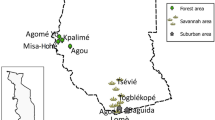Summary
Niche relationships among 11 diurnal lizard species were studied for 3 years. The community appeared to be subdivided spatially into different subsets of only four to six species. Coexisting species of each subgroup were separated further by differential utilization of microhabitats. In late spring and early summer, when food shortage is likely, dietary overlaps between syntopic species were generally low but increased broadly after the rains, when food became plentiful. Because of the high similarity in prey-size utilization among large and medium species, effects of prey selection according to size were generally slight except for very different-sized species. Overlap in the three-dimensional resource space was high between Cnemidophorus scalaris and C. tigris, but close observation of the ecology of the two populations showed many small differences between them. We suggest that the very diversified ecological opportunism of C. scalaris allows it to coexist with C. tigris in a very heterogeneous ecosystem. Several hypotheses are discussed to explain the ecological determinism of resource partitioning within such a community.
Similar content being viewed by others
References
Barbault R (1977) Etude comparative des rythmes journaliers d'activité des Lézards Cophosaurus texanus, Cnemidophorus scalaris et Cnemidophorus tigris dans le désert de Mapimi. Bull Soc Zool Fr 102:159–168
Barbault R (1981) Ecologie des populations et des peuplements. Des théories aux faits. Masson, Paris
Barbault R, Grenot C (1977) Richesse spécifique et organisation spatiale du peuplement de Lézards du Bolson de Mapimi (Mexique). C R Acad Sci Paris 284:2281–2283
Barbault R, Grenot C, Uribe Z (1978) Le partage des ressources alimentaires entre les espèces de Lézards du désert de Mapimi (Mexique). La Terre et la Vie 32:135–150
Barbault R, Halffter G (1981) A comparative and dynamic approach to the vertebrate community organization of the desert of Mapimi (Mexique). In: R Barbault, G Halffter (eds), Ecology of arid Mexico, Ecological organization of some vertebrate communities. Instituto de Ecologia, Mexico
Cody ML (1974) Competition and the structure of bird communities. Princeton University Press
Estabrook GF, Dunham AE (1976) Optimal diet as a function of absolute abundance, relative abundance, and relative value of available prey. Amer Nat 110:401–413
Fuentes ER (1976) Ecological convergence of lizard communities in Chile and California. Ecology 57:1–17
Huey RB, Pianka ER (1977) Patterns of niche overlap among broadly sympatric versus narrowly sympatic Kalahari lizard (Scincidae: Mabuya). Ecology 58:119–128
Jenssen TA (1973) Shift in the structural habitat of Anolis opalinus due to congeneric competition. Ecology 54:863–869
Lister BC (1976) The nature of niche expansion in west indian Anolis lizards. I. Ecological consequences of reduced competition. Evolution 30:659–676
MacArthur RH (1969) Species packing and what competition minimizes. Proc Nat Acad Sci USA 64:1369–1371
MacArthur RH (1970) Species packing and competitive equilibrium for many species. Theoret Pop Biol 1:1–11
MacArthur RH, Pianka ER (1966) on optimal use of a patchy environment. Amer Nat 100:603–609
Martinez Ojeda E, Morello J (1977) El medio fisico y las unidades fisonomico-floristicas del Bolson de Mapimi. Instituto de Ecologia, Mexico
Maury ME (1981a) Activity cycles of some lizards in Mapimi (Chihuahua desert, Mexico): biological and methodological consequences. In: R Barbault, G Halffter (eds), Ecology of arid Mexico. Ecological organization of some vertebrate communities. Instituto de Ecologia, Mexico
Maury ME (1981 b) Food partition of lizard communities at the Bolson de Mapimi (Mexico). In: R Barbault, G Halffter (eds), Ecology of arid Mexico. Ecological organization of some vertebrate communities. Instituto de Ecologia, Mexico
Maury ME, Barbault R (1981) The spatial organization of the lizard community of the Bolson de Mapimi. In: Barbault R, Halffter G (eds),. Instituto de Ecologia, Mexico
May RM (1975) Some notes on estimating the competition matrix. Ecology 56:737–741
Mitchell JC (1979) Ecology of southeastern Arizona whiptail lizards (Cnemidophorus: Teiidae): population densities, resource partitioning, and niche overlap. Can J Zool 57:1487–1499
Pianka ER (1966) Convexity, desert lizards, and spatial heterogeneity. Ecology 47:1055–1059
Pianka ER (1973) The structure of lizard communities. Ann Rev Ecol Syst 4:53–74
Pianka ER (1975) Niche relations of desert lizards. In: ML Cody, JM Diamond (eds), Ecology and evolution of communities, Harvard University Press, p 292–314
Pianka ER (1976) Competition and niche theory. In: RM May (ed), Theoretical ecology: principles and applications, Saunders, Philadelphia, p 114–141
Pianka ER, Huey RB (1978) Comparative ecology, resource utilization and niche segregation among gekkonid lizard in the southern Kalahari. Copeia:691–701
Pianka ER, Huey RB, Lawlor LR (1979) Niche segregation in desert lizards. In: DJ Horn, R Mitchell, GR Stairs (eds), Analysis of ecological systems, Ohio State Univ. Press. p 67–115
Pyke GH, Pulliam HR, Charnov EL (1977) Optimal foraging: a selective review of theory and tests. Quart Rev Biol 52:137–154
Rapport DJ, Turner JE (1977) Economics models in ecology. Science 195:367–373
Schoener TW (1968) The Anolis lizards of Bimini: resource partitioning in a complex fauna. Ecology 49:704–726
Schoener TW (1971) Theory of feeding strategies. Ann Rev Ecol Syst 2:369–404
Schoener TW (1974) Resource partitioning in ecological communities. Science 185:27–39
Schoener TW (1975) Presence and absence of habitat shift in some widespread lizard species. Ecol Monogr 45:232–258
Schoener TW (1977) Competition and the niche. In: C Gans, DW Tinkle (eds), Biology of Reptilia, Academic Press, vol 7:35–136
Thiollay JM (1979) Structure et dynamique du peuplement avien d'un mattoral aride (Bolson de Mapimi, Mexique). Terre et Vie 33:563–589
Author information
Authors and Affiliations
Rights and permissions
About this article
Cite this article
Barbault, R., Maury, ME. Ecological organization of a Chihuahuan desert lizard community. Oecologia 51, 335–342 (1981). https://doi.org/10.1007/BF00540903
Received:
Issue Date:
DOI: https://doi.org/10.1007/BF00540903




